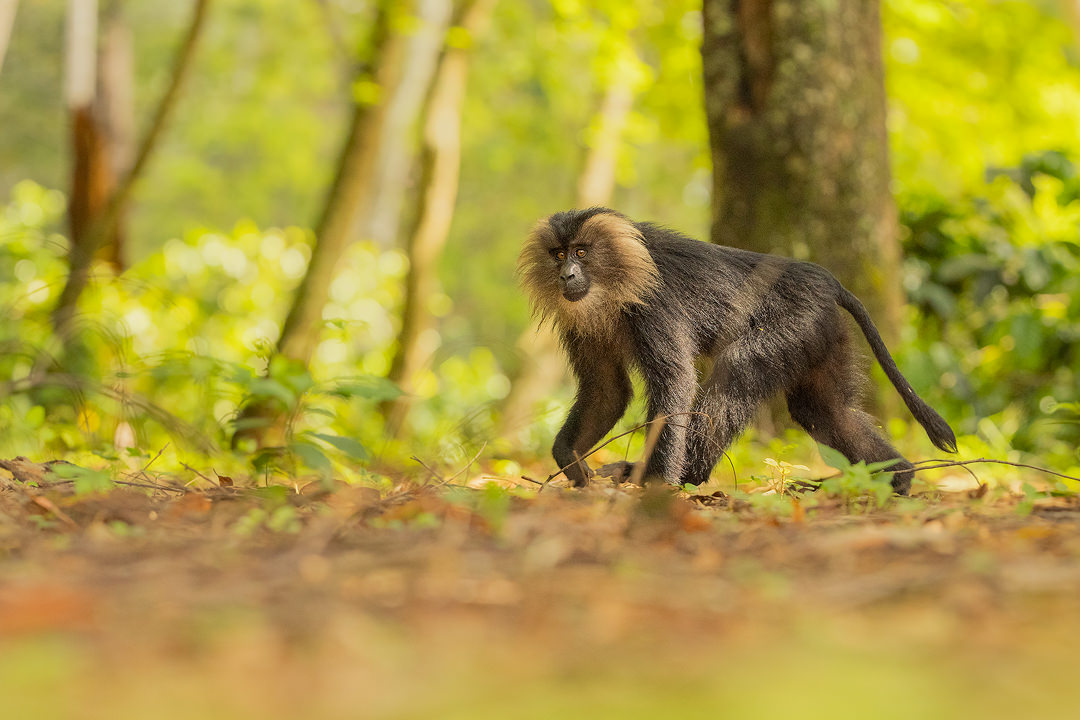Lion-tailed macaque on forest floor
Lion-tailed macaque on forest floor. Valparai, Western Ghats, India.
Lion-tailed macaque on forest floor – About the Lion-tailed macaque:
The lion-tailed macaque (Macaca silenus), also known as the wanderoo, is a fascinating and distinctive primate species only found in the lush rainforests of the Western Ghats in India. Named for its distinctive lion-like tail and mane-like tuft of hair framing its face, these are one of the smallest species of macaques in the world.
The Lion-tailed macaque is endemic and native exclusively to the Western Ghats and is unfortunately among the most endangered macaques on the planet. As a result of its shy and solitary nature, they very rarely venture from their usual range, traveling only within its rainforest habitat.
Living in the dense canopy of the rainforest, lion-tailed macaques are known for their striking appearance and unique behaviors. Their silver-gray fur and majestic, lion-like tuft set them apart from other macaque species. These agile and arboreal primates spend most of their time high up in the trees, leaping gracefully from branch to branch.
As omnivores, Lion-tailed macaques feed upon a wide range of foods. Fruits form the major part of their diet and they have been known to raid fruit farms, with a particular taste for jackfruit. Other foods include leaves, stems, flowers, buds, and fungi as well as insects, lizards, tree frogs, and various small mammals.
Lion-tailed macaques have a complex social structure, living in close-knit groups led by an alpha male. Within these troops, they exhibit intricate communication through various vocalizations and body language, fostering strong bonds among members.
Lion-tailed Macaque Conservation
These remarkable primates face a range of difficult challenges in their habitat. Deforestation due to human activities, such as logging and agriculture, threatens their survival. The fragmentation of their forest homes isolates populations and reduces their access to food sources.
The biggest overall threat to this species is the destruction of their rainforest habitat. Sadly these primates have lost as much as 99% of their original range as a result of large-scale deforestation for timber, agriculture, and development. Lion-tailed macaques live in isolated and fragmented populations facing a sharp decline. Additionally, the Lion-tailed macaques are frequently hunted and killed due to being mistaken for the similar coloured Nilgiri langur, which are commonly hunted for their meat. Other major threats include persecution as pest species due to raiding crops.
Conservation efforts are crucial to protect the future of lion-tailed macaques. Various organizations and wildlife sanctuaries work tirelessly to preserve their habitats, engage local communities in conservation initiatives, and raise awareness about the importance of these unique primates.
Encountering a lion-tailed macaque in the wild is an awe-inspiring experience. Observing their playful antics and graceful movements through the treetops is a reminder of the incredible diversity of life in the rainforests and the need to protect these precious ecosystems.
By supporting sustainable practices, advocating for conservation, and promoting responsible tourism, we can contribute to the preservation of lion-tailed macaques and their habitat. Together, we can ensure a future where these majestic primates thrive, continuing to enchant and inspire future generations.
You can find more about lion-tailed macaques here.
